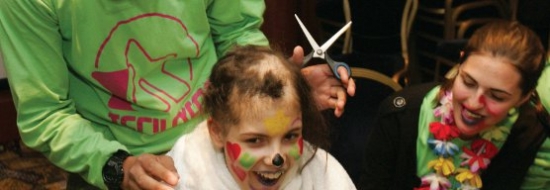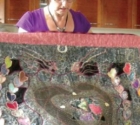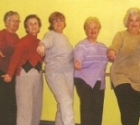
Hair is a valuable commodity and even penniless students can help enormously by giving theirs.
It’s a lonely business, being ill with cancer. Life narrows into you and the disease, day and night and relentless day: the nausea, the fatigue, the pain, the fear. The statistics are encouraging – recently released figures in the United States point to a continual decrease in mortality rates from cancer – and treatment is improving all the time. Yet the journey to recovery can be brutal: radio and chemotherapy cause weight loss, stomach issues, tingling in the fingers and the toes. Eating becomes an issue: what to eat and how to get the energy to eat and then how to ensure the food stays down. It’s a rough ride.
Losing your hair is, on the other hand, painless; it falls out during treatment and, in time, it grows right back. It’s a benevolent side effect: hair on your pillow doesn’t keep you up at night or make your insides ache when you wake up in the morning. But going bald is often one of the most disturbing aspects of the cancer treadmill. It alters your appearance and makes you look ill; without hair people battling cancer may feel vulnerable, and visibly different.
Chaim and Miri Erenthal know all about cancer, and chemo, and struggling with side effects. Their firstborn, Menachem, was struck by the disease when he was only one year old; for the next fifteen years he contended with it. In that time the couple had five more kids. When Menachem finally succumbed to cancer in 1990, aged 15, his parents established Zichron Menachem in his memory. This nonprofit organization, based in Jerusalem, incorporates a Day Care Center for children (and siblings) who are fighting cancer; or kids of parents with the disease. Here pupils can get extra help with schoolwork and prepare for their matriculation exams. But the Center is much more than a supplementary school; there are support groups for parents who have lost children, physiotherapy, fun activities such as photography and martial arts and even summer and winter camps including trips abroad.
This is the 20th consecutive year that doctors, nurses and psychologists have accompanied children to Europe (this year it’s to Holland, for 130 kids) for a time-out, both for them and their parents who remain at home. The support continues throughout the year: 35 kids get dinner and/or lunch at the Center each day. Children must be at least three years old to attend, and can stay at the Center till they have left school. Some families struggling with cancer are even given financial assistance.
And then there are the wigs.
With wigs, of course, there can’t be any bad-hair days. Wigs need to make a woman or a man, a boy or a girl feel good enough to walk out of the house with confidence and dignity; the hair of seven volunteers is needed in order to make one decent head of hair. It’s a mammoth task to keep the raw material coming. Avigail Weinfeld, who is in charge of the program, explains that Zichron Menachem has provided hundreds of wigs over the years, from thousands of donations. Patients have three options: if possible their own original hair is matched with what is available. A special custom-made hairpiece ensures that the patient’s appearance doesn’t change. Sometimes patients are connected with professional wig-makers and given financial aid to make the purchase – wigs are not cheap and can cost anything up to 7000 shekels. Some adults prefer to choose hair from the donated stock and have their own wigs designed.
Anyone with 25 centimeters of hair to spare can post it to the Center or pop in to one of the designated hair salons listed on the website. Gal Abelson, 21, has had her hair cropped twice for kids with cancer. “My hair grows fast,” she explains, “and this is my way of giving.” Abelson, who was active in the Israel Scouts and volunteered as an emissary to a summer camp in the States, and who has worked with special needs kids, says that most people don’t know about donating their hair. “After I told my boss at the coffee shop where I worked after the army, for example, she had her hair snipped off too. One of my male friends grew his hair long before the army, and then donated it as well – anyone can do it.”
Anyone can do it; but not many people know the value of their locks which normally land up on the hairdresser’s floor. Weinfeld, who has a close family member that successfully battled cancer a decade ago, promised herself that when this person recovered recovered she would do anything to make other patients’ lives easier. Now she does the rounds of schools in Israel (and some in the States), acquainting pupils with the program and explaining that it’s not necessary to give money in order to make a difference. Hair is a valuable commodity and even penniless students can help enormously by giving theirs. “In the States we have whole classes which organize ‘hair cutting days’ in a salon,” she explains, “and the girls share the experience (and trauma) of having their lovely long hair snipped off to shoulder length. It’s a real happening, and one which I hope to duplicate here in Israel as well.”
Cancer is indiscriminate and can hit anybody at all. One young woman who donated her hair discovered, soon afterwards, that she herself was suffering from the disease. A special wig was fashioned for her immediately – using her own tresses. Some people donate their curls after a loved one has recovered, in order to share their gratitude with those who are still on the path to health. And there is more good news for those who volunteer to share their hair; as well as the ‘feel-good’ factor one gets after a benevolent deed, the hairdressers who are part of the program will cut your hair for free. So check out www.zichron.org for a hairdressing salon closest to you, grow your hair a little too long for your needs and hurry over to share your bounty ... you’ll feel all the prettier for it, you’ll see.
 Israel: Reclaiming the Narrative - A Review
Israel: Reclaiming the Narrative - A Review ESRA Outing to Aida at Masada
ESRA Outing to Aida at Masada  Coffee Group for Immigrants enters 5th year
Coffee Group for Immigrants enters 5th year Yad Sarah's new house in Raanana
Yad Sarah's new house in Raanana English speaking Feldenkreis
English speaking Feldenkreis Men don't Make Passes at Girls who Wear Glasses
Men don't Make Passes at Girls who Wear Glasses Pamela Peled
Pamela Peled